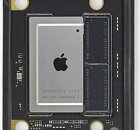Tuesday, November 24th 2020

Alleged Apple M1X Processor Specifications Surface
Apple's silicon design team has recently launched its "fastest" CPU core ever, found inside the company's M1 processor designed for laptops and mini-PCs. Featuring an eight-core processor, where four cores are represented by low power small configurations, and four big, high-performance design cores, the M1 processor proved to be extremely fast. However, the Apple Silicon processor doesn't seem to cover anything higher than the 13-inch MacBook Pro. And that is about to change. When it comes to higher-end models like the 16-inch MacBook Pro, which provides more cooling area, it is logical that the processor for those designs is a higher performance design.
Enter the world of the Apple M1X processor. Designed for high-end laptops and the most demanding workloads, the new processor aims to create a new performance level. Featuring a 12-core CPU with eight big and four small cores, the M1X processor is going to deliver much better performance than M1. The graphics and memory configuration are currently unknown, so we have to wait and see how it will look like. The M1X is set to arrive sometime in Q1 of 2021, according to the source of the leak, so be patient and remember to take this information with a grain of salt.
Source:
LeaksApplePro (Twitter)
Enter the world of the Apple M1X processor. Designed for high-end laptops and the most demanding workloads, the new processor aims to create a new performance level. Featuring a 12-core CPU with eight big and four small cores, the M1X processor is going to deliver much better performance than M1. The graphics and memory configuration are currently unknown, so we have to wait and see how it will look like. The M1X is set to arrive sometime in Q1 of 2021, according to the source of the leak, so be patient and remember to take this information with a grain of salt.

45 Comments on Alleged Apple M1X Processor Specifications Surface
Keep in mind that their non-X SoCs still only have 2 high performance cores with a couple of low performance (like, really low performance if you look at MT scaling) little cores that are apparently based on a 2012 design, that should give people an idea of just how bad they scale.
You keep forgetting that we are talking about mobile here. With low power budget. Why do you even bring a desktop CPU into this?
anything for these new devices is going to be coded specifically for them, so they'll run well but you can't compare them to anything else because its literally apples and oranges
Will we be able to use M1 to run anything outside of Apple propriety software? If not it's DOA for those of us who wouldn't want be "locked in", from a software perspective anyway.
Just to be clear. You are talking about the die size or transistor count? These two can be misleading. Just like the 2080Ti and 3080 are a different node so 2080 Ti is bigger in die size but 3080 packs more transistors. Just like Kepler vs Maxwell. The RDNA and RDNA2 are a better comparison since these are the same node. 6800 is almost twice as big as the 5700XT
We're talking about watt hours to complete tasks. A higher TDP doesn't mean higher watt hours if the higher watt chip is faster per watt. And don't pretend that it'll idle at higher power we're talking about a chip with E cores and core-off power states. The idle wattage will be identical.Are we just going to forget IPC, ILP and clockrate? On 28nm GM204 with 2B fewer transistors and 200mm smaller die overtook GK110B in performance. On 7nm RDNA took 3B fewer transistors on a 80mm smaller die to match and sometimes outperform the 13B transistors in GCN5.1. Architecture. It matters a lot.
A first gen Zen 1 core topped out at around 8-9W, a Zen 3 core tops out at 20W. A Zen 3 core is about 1.8X faster but uses 2.5X times the power and keep in mind that's on a much better node. Still don't believe that power efficiency takes a hit the more performance you extract ?No we are not, you are. No one uses a PC in the way you describe, I feel like I am repeating myself indefinitely, the bigger the chip and the higher the power consumption and the worse the battery life gets, even if performance/watt has increased. The only situation when that's not true is if the chip is used at maximum load until the battery dies, almost no one uses their device like that.